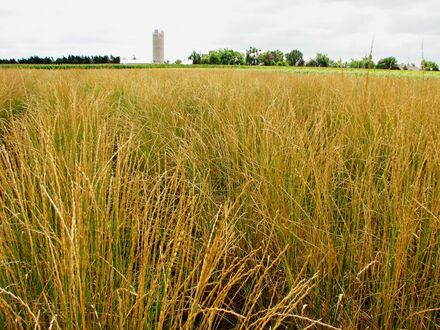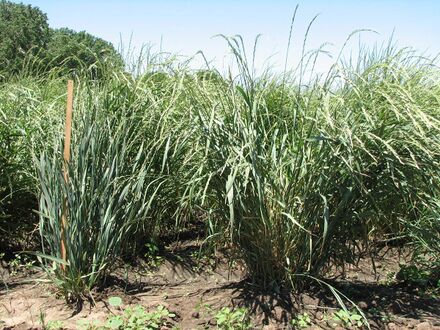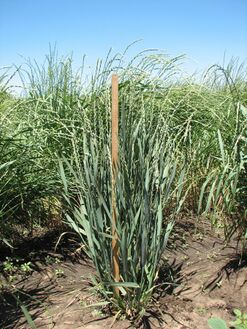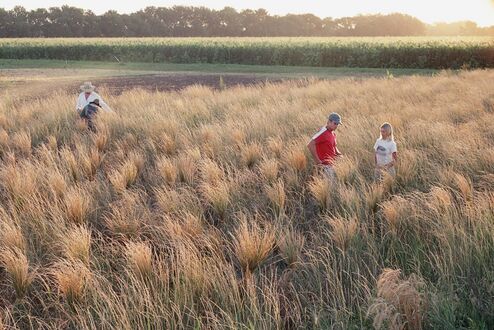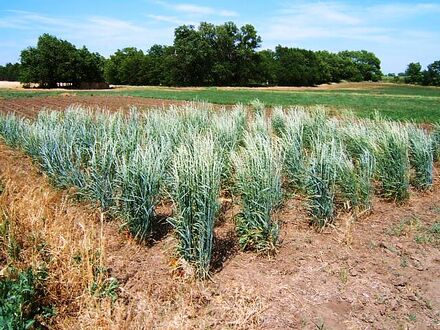Biology:Thinopyrum intermedium
| Thinopyrum intermedium | |
|---|---|
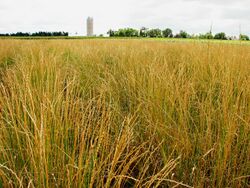
| |
| Scientific classification | |
| Kingdom: | Plantae |
| Clade: | Tracheophytes |
| Clade: | Angiosperms |
| Clade: | Monocots |
| Clade: | Commelinids |
| Order: | Poales |
| Family: | Poaceae |
| Subfamily: | Pooideae |
| Genus: | Thinopyrum |
| Species: | T. intermedium
|
| Binomial name | |
| Thinopyrum intermedium (Host) Barkworth & D.R. Dewey
| |
Thinopyrum intermedium, known commonly as intermediate wheatgrass,[1] is a sod-forming perennial grass in the Triticeae tribe of Pooideae native to Europe and Western Asia.[2] It is part of a group of plants commonly called wheatgrasses because of the similarity of their seed heads or ears to common wheat. However, wheatgrasses generally are perennial, while wheat is an annual. It has gained the Royal Horticultural Society's Award of Garden Merit as an ornamental.[3]
Trials with intermediate wheatgrass, the product of which is trademarked by the Land Institute as "Kernza", show that it can be grown as a "multi-functional" crop, yielding various commodities as well as ecosystem services. Whereas annuals such as corn tend to deplete soil organic matter and require inputs, a perennial grain such as intermediate wheatgrass can yield crops while building soil organic matter.[4][5]
Synonyms
Scientific names
Many scientific binomial names have been given to the species Thinopyrum intermedium. Multiple species or subspecies have been described based on different morphologies, like if parts of the plants are pubescent (that is, covered with "hairs") or not. Here is a partial list of the binomial synonyms for Thinopyrum intermedium:[6]
- Agropyron aucheri
- Agropyron ciliatiflorum
- Agropyron gentryi
- Agropyron glaucum
- Agropyron intermedium
- Agropyron podperae
- Agropyron pulcherrimum
- Agropyron trichophorum
- Elymus hispidus
- Elytrigia intermedia
Common names
Intermediate wheatgrass is the most widely used common name for Thinopyrum intermedium in the United States. The name "intermediate" probably refers to the height of the plant, which is generally somewhat shorter than T. ponticum known by the common name of "tall wheatgrass".[citation needed]
Wild triga is the common name that was given to Thinopyrum intermedium by researchers at The Rodale Institute. The name was intended to distinguish varieties of the species developed for use as a perennial grain crop from forage cultivars which are identified by the common name "intermediate wheatgrass".[7]
Kernza is a trademarked name held by the Land Institute for the processed grains of intermediate wheatgrass.[5]
Origin and distribution
The native range of intermediate wheatgrass extends from central and southeastern Europe to Asia Minor. Although it was first brought to the United States in 1907, the first successful introduction was from the Caucasus region in 1932.[8] The plant can now be found growing wild throughout the Western United States and Western Canada.[6][9]
T. intermedium is best adapted to:[6][failed verification]
- Regions with annual rainfall between 12 and 30 inches (30 and 76 cm)
- Soil with a pH between 5.6 and 8.4
- Locations with full exposure to the sun
- A wide range of soils but with a minimum depth of 16 inches (41 cm)
- Locations where the minimum temperature exceeds −38 °F (−39 °C)
Uses
Forage
Thinopyrum intermedium is among the most productive forage species for the western United States. Because it heads relatively late, it can be grown effectively in mixture with alfalfa to increase its productivity, longevity, and forage quality. It regrows slowly after grazing or cutting, making it best suited to management with a single harvest per year.[10] If multiple harvests are needed per year, other species will be more productive. If managed well, stands can persist for up to 50 years.[citation needed]
Habitat
Habitat for wildlife - intermediate wheatgrass can be an excellent food source for grazing and browsing animals. Left unharvested, the vegetation is a good nesting habitat for some birds and waterfowl. Generally, it is not an invasive plant and coexists well with native plant species.[citation needed]
Soil management
Soil management by way of erosion control and land rehabilitation are additional uses for this plant. It establishes quickly to form a protective mat of roots and rhizomes, even when planted on soils degraded by earth moving or mining. Within five years, stands have produced up to 7,000 pounds per acre (7,800 kg/ha) of dry root mass in the top 8 inches (20 cm) of soil.[10] Heavy root production holds the soil in place and restores its natural fertility by increasing soil carbon.[citation needed]
Grain
Thinopyrum intermedium is a perennial grain crop. In 1983, the Rodale Research Center evaluated close to 100 species of perennial grasses to identify those with good potential for development into perennial grain crops. Intermediate wheatgrass was selected as the most promising species based on flavor, ease of threshing, large seed size, resistance to shattering, lodging resistance, ease of harvest, and perennial growth.[11] Intermediate wheatgrass is nutritionally similar to wheat, and the grain can be ground into flour and used for food products, including muffins, tortillas, pancakes, cookies, crackers, bread, beer and whisky. Some products have been marketed under the trade name Kernza.[12]
Seed production
Although the primary use of Thinopyrum intermedium is as a forage, seed production is essential because farmers and ranchers continue to establish new stands by planting the seed. In 1988 over 500 metric tons (550 short tons) of seed were harvested in Saskatchewan alone, although more recently the harvest has fallen to less than 225 metric tons (248 short tons) in that Canadian province.[13] Average seed yields are about 330 pounds per acre (370 kg/ha), but on-farm yields of up to 880 pounds per acre (990 kg/ha) have been achieved. Seed is generally produced in rows spaced 30 to 36 inches (76 to 91 cm) apart. The wide row spacing (relative to grain crops like wheat) allows for sustained seed yields for five to ten years. Without spacing and occasional tillage between the rows, yields decline rapidly as the plant population becomes increasingly dense through rhizome spread. Despite this, T. intermedium is still considered lesser than wheat by some, as its seeds are comparatively tiny.[14]
Breeding for grain production
Intermediate wheatgrass, Thinopyrum intermedium, has been widely hybridized with wheat in the effort to transfer traits such as disease resistance or perenniality.[15] Transferring leaf rust- and powdery mildew-resistance to wheat has been a special interest.[16] But, attempts to directly domesticate the species into a grain crop did not commence until workers at the Rodale Research Center began to evaluate collections in 1983.[17] In 1989, after assessing 300 collections, the workers selected the best twenty based on grain yield and seed quality. The selected collections were allowed to intermate, and 380 progeny were evaluated between 1991 and 1994. The best eleven plants, plus three from another evaluation, had intermated, causing a second cycle to begin. Seeds from the best plants in the second cycle were passed to scientists at The Land Institute, where the research has continued.
In 2001 and 2002, seed from the first and second breeding cycles of the Rodale Research Center was planted at The Land Institute. In the fall of 2003, 1000 individual plants were dug up and vegetatively propagated to obtain three clones of each plant. The 3000 resulting plants were randomly transplanted to the field on a three foot by three-foot grid. In this manner, genetic differences between plants were separated from environmental influences. In 2005, heads were harvested from every plant and threshed to remove the seeds. The seeds were both counted and weighed to determine the yield per seed head and weight per seed. The fifty plants with the highest yield and largest seed were selected to intermate in 2004.[citation needed]
In the fall of 2004, 4000 progeny were planted to establish the second cycle of breeding at The Land Institute. In 2008, these plants were harvested separately by using a power scythe and threshed in a combine. Again the best 50 plants were selected, this time based on yield per head, seed size, shortness, and free-threshing ability.
The selection methods described above have increased seed size and yield by about 10 to 18% per cycle.[18] But perhaps of greater importance has been the discovery of two Mendelian traits. The first is dwarfing, which results in stems about 30 centimetres (1 ft 0 in) shorter than wild-type plants and short, erect leaves. The second is a more subtle change in head shape which results in thick, non-brittle heads and slightly larger seeds. Both of these traits appear to be controlled by dominant genes.
The whole process mentioned above is called mass selection, which is breeding and selecting the best individuals to spawn the next generation. (Mass breeding, however, is a process by which large quantities of genetically diverse individuals are made.) Due to T. intermedium's grass-like structures, some believe that it still needs to be domesticated as much as possible to resemble wheat.[19]
The fact that T. intermedium is a perennial grass is important with regards to its use as a grain. The plant persists and can be harvested year after year, and its domestication would yield an additional three months of agriculture; its leaves are most active in the months in which common wheat is not active: July through September. Despite the promise, the yield per acre of Thinopyrum intermedium is 26% of the yield of traditional wheat. Because of this, some are putting effort into hybridizing wheat and T. intermedium instead of attempting to domesticate T. intermedium to a more acceptable yield.[20]
Hybridization with wheat
T. intermedium has been hybridized with wheat since the 1940s.[21] This confers some advantages. First, hybridization of T. intermedium with wheat transfers fungal- and viral-resistances to domestic wheat plants.[21] However, which specific genes protect against which specific fungi is not known. T. elongatum and T. intermedium impart a total of four leaf rust resistance genes, while T. intermedium confers two powdery mildew resistance genes.[22] There's evidence that T. intermedium also has resistance to wheat streak mosaic virus, the Aceria tosichella mite, Barley yellow dwarf, and others.[23] These conferred genes in wheat help increase yield and hardiness in times of environmental strain. Second, T. intermedium also has genes that improve bread making when hybridized with common wheat. While this may not seem like an important characteristic, better bread may mean more calories, feeding more people. In addition, bread that stays fresh longer may provide more opportunities for people to be adequately fed, and/or the bread can be transported to areas without much food access.[24]
Strategies for domestication
The Land Institute has been working to develop viable wheat and Thinopyrum intermedium hybrids since 2001, and there have been several successful strains that shared 14 T. intermedium chromosomes and 42 wheat chromosomes. These hybrids perform better regarding yield and resistance than either of their parents, but it cannot be widespread[clarification needed] due to the changes[clarification needed] of climate across the world. Also, perenniality is lost with these hybrids. This loss of perenniality is a common problem with hybridization attempts. All other desired characteristics are present in the hybrids - large seeds, good yields, etc. However, crosses between durum wheat and T. intermedium have resulted in hybrids that do exhibit perenniality in addition to other desired characteristics (increased vigor, hardiness in colder weather, good yield).[25]
There are three general strategies for domestication of T. intermedium with the purpose of creating an alternative grain crop:
- One strategy is to domesticate T. intermedium through mass breeding and selection to create a strain that mimics wheat's seed size and yield but retains T. intermedium's natural resistances, hardiness, and perenniality. In other words, this strategy gives T. intermedium more wheat-like characteristics;
- A second strategy is to hybridize wheat with T. intermedium to create a strain of wheat that mimics T. intermedium's resistance and perenniality but retains wheat's seed size and yield. In other words, this second strategy gives wheat more T. intermedium-like characteristics. Researchers hope that these two strategies will progress and meet in the middle.[19]
- A third strategy is to benefit from what we know about the molecular events that led to the domestication of evolutionarily related grasses such as wheat and barley. Mutations in so-called domestication genes in wild ancestors led to the domestication phenotypes that characterize these crops today. If related genes can be identified in T. intermedium it may be possible to mutate them by new breeding technologies (targeted mutagenesis, genome editing), and in this way accelerate domestication.[26]
Kernza
Diseases and pests
Black grassland bugs can be a problem for the cultivation of Thinopyrum intermedium, as they can cause severe damage on the wheatgrass plants.[27] Heavy infestation can reduce seed production and coupled with unfavourable conditions lead to plant mortality. By feeding on the plants, the bugs destroy cells and the destruct or remove chlorophyll, leaving whitish spots on the plant leaves.
Disease and pest management
Thinopyrum intermedium is a perennial plant, which means that usual methods of disease management used for annual grain production might not be applicable and efficient. Also, common herbicides used in annual grain cultivation are not approved for use with intermediate wheatgrass. Therefore, different approaches are necessary to disrupt diseases cycles of multiple pathogens in Kernza grain production.[28]
Resistance is an important factor when managing the perennial grain crop, as resistance is a defense which is active continuously and no application of active substances is needed throughout the year. T. intermedium has shown resistance against four major cereal pathogens. These are Barley yellow dwarf and wheat streak mosaic diseases, viral diseases which can cause complete yield loss without control and tan spot caused by the fungus Pyrenophora tritici-repentis and take-all caused by the fungus Gaeumannomyces graminis var. tritici.[29]
Cultivars of Kernza
Certified seed of the improved seed material are available at Crop Improvement Associations or from commercial sources. The cultivars differ in area of origin, selection traits and in regard to their purpose.[30]
Nutritional values and use of Kernza
Kernza contains higher values of protein, ash content and dietary fiber content when compared with wheat. Further 100 gram uncooked Kernza provides 1540 kilojoule (368 kcal) of food energy and is a good source of calcium (120 mg) as well as iron (5.5 mg). Comparing Kernza to white[clarification needed] wheat berries, calcium contents are 4.8 times higher and iron values are more than double. Kernza contains gluten but is deficient in high molecular weight glutenin, which limits its use especially in baking. The higher fat content in Kernza may increase overall rancidity, but a higher antioxidant content than wheat may offer a protective effect.[31][32] There are existing products with Kernza such as Honey Toasted Kernza by Cascadian Farms[33] and Patagonia Provisions’ Kernza beer.
Management practices
There is little known about management practices regarding specifically Kernza. According to the official Kernza webpage[34] Kernza is already being intercropped with legumes and in an article of the StarTribune, it is said that in the Upper Midwest of the US, Kernza should be sown not later than the 1st of September to ensure root establishment before winter. However, there are still field trials being done to examine nitrogen, phosphorus and potassium fertilisation rates and application timing to maximize grain and forage yields.[35]
Cold stress acclimation
An important aspect of cold stress acclimation is increased expression of DNA repair genes[36]. In T. intermedium, conditions of freezing stress are associated with large increases in expression of two DNA repair genes (one gene product a photolyase and the other, a protein employed in nucleotide excision repair)[36].
Gallery
References
- ↑ "Thinopyrum intermedium". Natural Resources Conservation Service PLANTS Database. USDA. https://plants.usda.gov/core/profile?symbol=THIN6. Retrieved 9 December 2015.
- ↑ The Grass Manual: Thinopyrum intermedium (intermediate wheatgrass) accessed 2013-01-31
- ↑ "AGM Plants March 2020 © RHS – ORNAMENTAL". The Royal Horticultural Society. March 2020. https://www.rhs.org.uk/plants/pdfs/agm-lists/agm-ornamentals.pdf.
- ↑ Intermediate Wheatgrass. Green Lands Blue Waters. Retrieved: 2013-10-26.
- ↑ 5.0 5.1 Trademark information. Kernza. LegalForce. Retrieved: 2013-10-26.
- ↑ 6.0 6.1 6.2 USDA PLANTS Database
- ↑ Wild Triga
- ↑ Intermediate wheatgrass fact sheet
- ↑ The Grass Manual: Distribution map for Thinopyrum intermedium (in North America; introduced species) . accessed 1/31.2013
- ↑ 10.0 10.1 Intermediate Wheatgrass Plant Guide
- ↑ Wagoner, P., and A. Schauer. 1990. Intermediate wheatgrass has as a perennial grain crop. p. 143-145. In: J. Janick and J.E. Simon (eds.), Advances in new crops. Timber Press, Portland, OR.
- ↑ How We Can Tame Overlooked Wild Plants to Feed the World | WIRED
- ↑ Seed Production of Intermediate Wheatgrass
- ↑ Becker, Robert (1991). "Compositional, nutritional and functional evaluation of intermediate wheatgrass". Journal of Food Processing and Preservation 15 (1): 63–77. doi:10.1111/j.1745-4549.1991.tb00154.x. https://zenodo.org/record/1230714.
- ↑ Cox et al. 2002 Breeding Perennial Grain Crops. Critical Reviews in Plant Science 21:51-91
- ↑ Salina, Elena (July 2015). "A Thinopyrum intermedium chromosome in bread wheat cultivars as a source of genes conferring resistance to fungal diseases". Euphytica 204: 91–101. doi:10.1007/s10681-014-1344-5. http://apps.webofknowledge.com.ezp.slu.edu/full_record.do?product=WOS&search_mode=GeneralSearch&qid=1&SID=1CucWnF632RUuu6Ajt7&page=1&doc=1.
- ↑ A. Schauer, 1990. Evaluation of Intermediate Wheatgrass Germplasm. Rodale Research Center, Kutztown, Pennsylvania.
- ↑ Cox 2008
- ↑ 19.0 19.1 Dehaan, Lee (2014). "Current efforts to develop perennial wheat and domesticate Thinopyrum Intermedium as a perennial grain". Genetics and Breeding: State of the Art, Gaps and Opportunities. 01: 72–89. https://www.researchgate.net/publication/267392296.
- ↑ Cox, Thomas (August 2006). "Prospects for Developing Perennial Grain Crops". BioScience 56 (8): 649–659. doi:10.1641/0006-3568(2006)56[649:PFDPGC2.0.CO;2].
- ↑ 21.0 21.1 Li, Hongjie; Wang, Xiaoming (2009). "Thinopyrum ponticum and Th. intermedium: the promising source of resistance to fungal and viral diseases of wheat" (in English). Journal of Genetics and Genomics (Beijing: Elsevier China) 36 (9): 557–565. doi:10.1016/S1673-8527(08)60147-2. ISSN 1673-8527. PMID 19782957.
- ↑ Salina, Elena (January 25, 2015). "A Thinopyrum intermedium chromosome in bread wheat cultivars as a source of genes conferring resistance to fungal diseases". Euphytica 204 (1): 91–101. doi:10.1007/s10681-014-1344-5.
- ↑ Cox, Thomas (2006). "Prospects for Developing Perennial Grain Crops.". BioScience 56 (8): 649–659. doi:10.1641/0006-3568(2006)56[649:PFDPGC2.0.CO;2]. http://bioscience.oxfordjournals.org/content/56/8/649.abstract.
- ↑ Garg, Monika (2014). "Introgression of useful genes from Thinopyrum intermedium to wheat for improvement of bread-making quality". Plant Breeding 133 (3): 327–334. doi:10.1111/pbr.12167.
- ↑ Dehaan, Lee (2014). "Current efforts to develop perennial wheat and domesticate Thinopyrum Intermedium as a perennial grain". Genetics and Breeding: State of the Art, Gaps and Opportunities 01: 72–89. https://www.researchgate.net/publication/267392296.
- ↑ DeHaan L, Larson S, López-Marqués RL, Wenkel S, Gao C, Palmgren M (2020). "Accelerated Domestication of an Emerging Perennial Grain Crop". Trends in Plant Science 25 (6): 525–537. doi:10.1016/j.tplants.2020.02.004. PMID 32407693.
- ↑ Malechek, J. C.; Gray, A. M.; Haws, B. A. (1977-03-01). "Yield and Nutritional Quality of Intermediate Wheatgrass Infested by Black Grass Bugs at Low Population Densities" (in en). Journal of Range Management 30 (2): 128–131. doi:10.2307/3897754. ISSN 0022-409X. https://repository.arizona.edu/handle/10150/646831.
- ↑ Approaches to Managing Intermediate Wheatgrass for Dual-Use Forage and Kernza Perennial Grain Production. 2019. Developed by y Green Lands Blue Waters, the University of Minnesota Department of Agronomy and Plant Genetics, the University of Wisconsin–Madison Agronomy Department, the Forever Green Initiative, The Land Institute, and farmer partners.
- ↑ Cox, C. M.; Garrett, K. A.; Cox, T. S.; Bockus, W. W.; Peters, T. (2005-11-01). "Reactions of Perennial Grain Accessions to Four Major Cereal Pathogens of the Great Plains". Plant Disease 89 (11): 1235–1240. doi:10.1094/PD-89-1235. ISSN 0191-2917. PMID 30786449.
- ↑ Govaerts, Rafaël (2017). World Checklist of Selected Plant Families | COL. doi:10.48580/d4sl-38c. https://www.catalogueoflife.org/data/dataset/1024. Retrieved 2021-11-24.
- ↑ "Kernza". https://kernza.org/wp-content/uploads/Kernza-as-a-Cereal-Grain-FINAL.pdf.
- ↑ "Baking with Kernza". 17 August 2021. https://perennial-pantry.com/blogs/perennial-test-kitchen/kernza-in-depth.
- ↑ "A climate smart cereal with CFANS roots | College of Food, Agricultural and Natural Resource Sciences" (in en). https://cfans.umn.edu/news/climate-smart-cereal-cfans-roots.
- ↑ "Kernza". https://kernza.org/.
- ↑ Kernza crop failure sends General Mills unit to remake plans for new cereal – StarTribu ne.com Kernza CAP - Kernza
- ↑ 36.0 36.1 Jaikumar NS, Dorn KM, Baas D, Wilke B, Kapp C, Snapp SS. Nucleic acid damage and DNA repair are affected by freezing stress in annual wheat (Triticum aestivum) and by plant age and freezing in its perennial relative (Thinopyrum intermedium). Am J Bot. 2020 Dec;107(12):1693-1709. doi: 10.1002/ajb2.1584. Epub 2020 Dec 19. PMID: 33340368
External links
Wikidata ☰ {{{from}}} entry
 |




